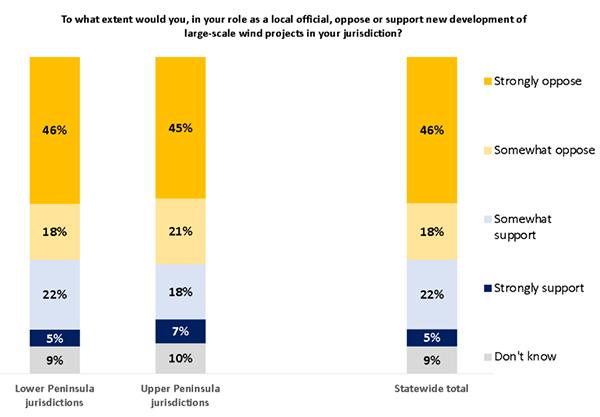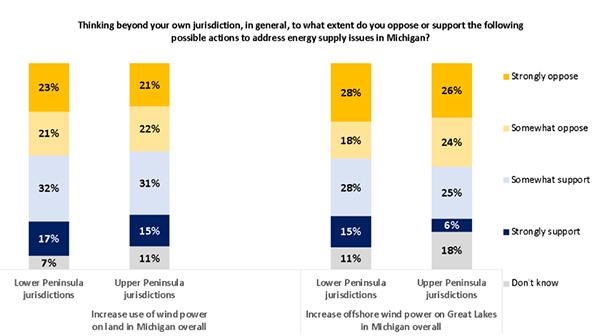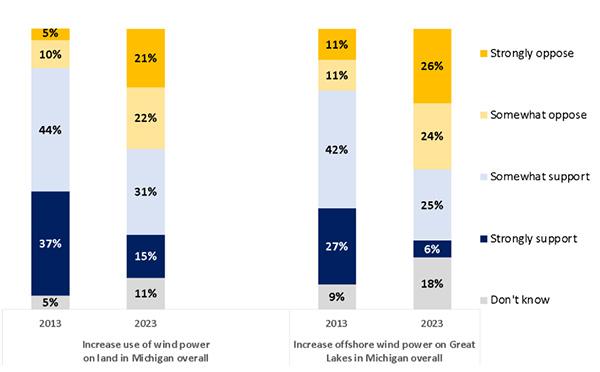By Katelyn Jasmin of CLOSUP
for Rural Insights
When I was a young child, I saw my first wind turbine in the hills of Iowa when my family was driving from Michigan to Colorado. Many people consider them an eyesore, but I thought they looked absolutely wonderful. They were like giant pinwheels that I thought could fly into the sky at any moment. Soaring through the clouds like an adventurer who doesn’t know where they’re going, but simply enjoying the journey. Quite a dazzling life to give a wind turbine, isn’t it?
The reality of these giants is less fantastical, however. Wind turbines are part of a bigger discussion on renewable energy and sustainability as a whole. There have been discussions in both state and the federal governments if they should be used as an alternative source of energy, rather than fossil fuels, in order to reduce carbon emissions. In Michigan, though, opinions on this renewable energy source are complex.
In fall 2023, the University of Michigan’s Center for Local, State, and Urban Policy (CLOSUP) conducted a statewide survey on energy issues. According to CLOSUP’s survey data, around two-thirds (~66%) of the local officials in U.P. counties, cities, villages and townships oppose large scale wind projects in their own jurisdiction (see Figure 1 on pg. 5).
As for increasing wind energy on land generally across the state, the divide between those who support and oppose it is more evenly split, but still around half of local leaders statewide oppose it. When it comes to increased offshore wind energy on the Great Lakes, there’s even less support. The percentages vary, but one commonality is that either “strongly support” or “don’t know” is always the lowest. (See Figure 2 on pg. X)
This data is particularly intriguing because there’s such a strong opposition to large wind projects with one’s own jurisdiction, but that strong opposition is halved when it comes to increasing wind energy in the state overall. This may be due to the ‘Not in my backyard’ or NIMBY syndrome: People like the idea of developing wind energy, but not where they live. The U.P. officials’ assessments are also interesting because they generally parallel the overall opinions of Lower Peninsula leaders on land-based wind, but when it comes to increasing offshore wind energy, there is less support among local leaders in the U.P. than among those in the Lower Peninsula.
Opposition to wind energy wasn’t always this strong in the state, however. A decade ago, in 2013, CLOSUP conducted a different survey that asked the opinions of local government officials on issues related to wind energy. The results are surprising when one compares the answers to the 2023 data. (See Figure 3 on pg. 5)
There previously was much more support for wind energy among Michigan officials, including those from the U.P. The support for wind projects within one’s own jurisdiction and expansion of land-based wind energy was much more positive. In both areas, the percentage of those who said ‘strongly oppose’ is a fraction of the amount today. Overall, in 2013 the majority (81%) of local government officials in the U.P. supported additional land-based wind energy across the state. Today, only 46% support increasing land-based wind energy in the state, and only 31% support expanding off-shore wind.
Historically, U.P. officials had a more enthusiastic attitude about the future prospects of wind energy, which is a stark contrast to many attitudes today. So, we may ask ourselves, how did we get here?
For starters, wind energy isn’t the perfect renewable energy option; like all types of energy production, it has its drawbacks. Visual or noise impacts were the biggest discouraging factors for the development of wind energy in 2013 as reported by local officials at the time. Other cited drawbacks include negative impacts on local wildlife, lack of efficiency as they can only be placed in areas with consistent wind, and potential environmental impacts (particularly if they’re built offshore). However, there may be a more intricate reason at play here.
Michigan, particularly the U.P., is heavily dependent on its tourism industry; for the U.P., it’s a strong source of economic income. As a result, the state spends a lot of time and money advertising its untold natural gems to the outside world and prioritizes keeping them in optimal condition — particularly, the ethereal coastline views of the Great Lakes.
As someone from a Michigan coastal town, I can attest to this from seeing the multitude of hotels blocking said view so that their customers can pay to see it. Given that many people find wind turbines visually unappealing, putting them offshore would impact the picturesque view that many tourists come to Michigan to see. This is especially tricky since the most optimal place to put the turbines is on the coastline, the area with the greatest amount of wind. This may explain why support for offshore wind energy was even lower than land-based wind energy among the U.P. jurisdictions.
There’s a tragic irony to this, however. The main reason renewable energy is needed is because our reliance on fossil fuel energy contributes vast amounts to CO2 emissions, which in turn contributes to climate change. As a result of the changing climate, the U.P. and Michigan as a whole is seeing less and less snowfall.
This is concerning, because the U.P. relies not only on summer tourism, but winter tourism as well. With no snow, there was a devastating hit to winter tourism businesses in the U.P. Because of increased temperatures, there’s also an increased chance of forest fires during the summer, which can lead to health impacts from smoke inhalation. During the Canada forest fires last summer, the U.P. was covered in smoke and it was hard to breathe when one went outside.
It’s important to consider the deeper aspects of Michigan’s change in opinion on wind energy. This could cause conflicts between the two levels of government as the State turns to preemption in order to move clean energy projects forward. This could also increase tensions between rural and urban communities as most wind energy projects will be in rural areas.
Wind power is not a perfect option and it might not even be the best one for the U.P. or Michigan as a whole. However, the deterioration of support for it over the past 10 years points to a deeper issue of sustainability in Michigan. It’s important that we Michiganders question if our reliance on tourism is holding us back from advancing toward a greener, more sustainable future.
In the end, tourism may be more of a detriment for the U.P. than a benefit. Yes, it provides job opportunities and economic income to the region, but the industry is under pressure from a changing climate. Where does that leave the business and people who rely on it? Where does it leave the U.P.?
It’s time that we become self-reliant, focusing on growing and improving our communities. We have so much opportunity to expand our horizons and explore avenues that we had never previously dreamed of. Though, it’s important that we always think conscientiously while we do this, so that we can build a community where we work with our environment instead of against it. We can’t equate progress and development with the sacrifice of the natural environment.
This is the vision I have for Michigan and my U.P. community. I think we truly have the ability to build a better future where we can be free from the confines of industrialization and live in a way that sustains everything and everyone for generations to come. I’ve always looked at things through a fantastical lens, in which there can be giant pinwheels flying through the sky. Yet, I think this vision is something that can come true if we look at the world around us and grow towards a more sustainable way of living, wind energy or no wind energy.
[This article draws on data from statewide surveys of local government leaders from the Michigan Public Policy Survey. The fall 2023 wave received responses from 135 Upper Peninsula jurisdictions. The fall 2013 wave received responses from 142 Upper Peninsula jurisdictions.]
Editor’s Note: This article has been edited for length. Rural Insights is a nonprofit online publishing outlet focused specifically on issues affecting the U.P. and its residents. To learn more or to sign up for its newsletter, visit ruralinsights.org.




